Inflamed tonsils in the throat. What are the tonsils: the structure, function, possible pathology
People know about tonsils when they become inflamed. True, the second question immediately arises: "Why do we need tonsils?"
To get an accurate and competent answer, you need to find out for yourself the following: where the glands are located; the structure of the tonsils; tonsil function.
How to see and where are
The glands are small specific formations of lymphoid tissue. In total there are 6 of them: two paired and two unpaired. Together they form a pharyngeal ring. The tonsils are located in the place where the nasopharynx passes into the pharynx. As for the size, they can be compared with the average walnut. By the way, they got the name “tonsils” due to the external similarity with him. That's just the color they have pink. Note that saying "" is wrong. It is the same. If inflammation occurs, they change their appearance. Why do you need tonsils? Basically, to protect the body.
When the lymph nodes in the neck become inflamed, they are often confused with the glands. To clearly understand what specifically bothers a person, you need to know where the tonsils are located.
To inspect the tonsils in the throat and mouth, a person is examined with endoscopic equipment that is connected to a computer monitor. With the help of a special apparatus, the doctor easily examines every amygdala. He can even show the image to the patient, along the way explaining where they are located and what their appearance says.
What are
Glands are usually classified according to the place where they can be. Thus, they are:
- palatine (paired);
- pharyngeal or nasopharyngeal (unpaired);
- pipe (pair);
- lingual (unpaired).
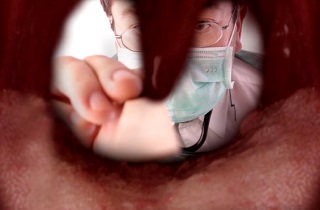
Consider more:
Tonsil device
All the tonsils, and the structure, and the structure of which is almost the same, yet have a number of features:
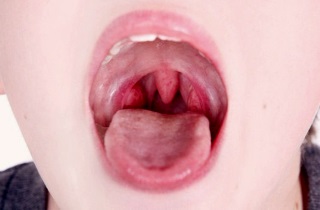
Each tonsil, both in the throat and in the mouth, has follicles over its entire surface as well as inside. When the glands are healthy, the right amount of plasma cells, macrophages and lymphocytes is actively produced in them and in the gaps.
These cells fight infections that affect the upper respiratory tract. If a person falls ill with angina, then they, along with foreign microorganisms, are part of the pus contained in the lacunae and follicles.
What are the tonsils for?
 All people are born with a full complement of 6 tonsils. Peak development of the glands reaches even in the first years of the child's life. But when sex hormones begin to appear (approximately at the age of 15-16 years old), they are regressed - there is a gradual atrophy and a decrease in the tonsils in size.
All people are born with a full complement of 6 tonsils. Peak development of the glands reaches even in the first years of the child's life. But when sex hormones begin to appear (approximately at the age of 15-16 years old), they are regressed - there is a gradual atrophy and a decrease in the tonsils in size.
Tonsils and their functions in the human body to this day are not fully understood. However, their main role is defined. It is to protect and create local immunity, which is opposed to pathogenic microbes that enter the body through the airborne pathway.
Nature assigned several functions to the glands, with which they, being healthy, successfully cope:

We emphasize that the amygdala performs all of these functions in full only when they are in order. When their tissues are affected by inflammation, the entire body suffers. His self-defense ability drops significantly. Because of this, the risk of developing various complications increases, which can adversely affect any kind of organs and even their systems.
Interestingly, the amygdala sometimes gives a certain tone of speech in general and the timbre of the voice in particular. This nuance must be taken into account, if it is shown that they are removed from patients who work with their voices (television broadcasters, pop performers, teachers, etc.).
By the way, “French pronons” in some cases can be the result of overgrown adenoids or an increase in palatine tonsils.
Is it necessary to delete
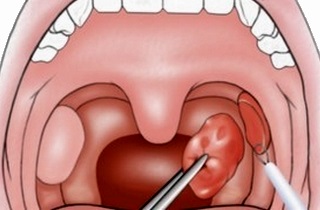 The topic “Why does a person have tonsils?” Has been debated for many decades. Today, most doctors have concluded that the removal of tonsils should be resorted to only when their chronic sluggish inflammation causes significant damage to the body and because of them lymph nodes around the neck periodically inflamed. In addition, such an operation is justified if the patient is diagnosed with chronic tonsillitis, which is not amenable to conservative methods of treatment. With the pathological proliferation of tonsil tissue in humans, it is difficult to promote food, it becomes difficult to swallow. In this case, of course, there is no other way out.
The topic “Why does a person have tonsils?” Has been debated for many decades. Today, most doctors have concluded that the removal of tonsils should be resorted to only when their chronic sluggish inflammation causes significant damage to the body and because of them lymph nodes around the neck periodically inflamed. In addition, such an operation is justified if the patient is diagnosed with chronic tonsillitis, which is not amenable to conservative methods of treatment. With the pathological proliferation of tonsil tissue in humans, it is difficult to promote food, it becomes difficult to swallow. In this case, of course, there is no other way out.
AT early age removing the tonsils is also undesirable because, apparently, they do not allow food allergies to appear. According to statistics, 70% of children who have had their tonsils removed suffer from dysbiosis and food allergies.
If purulent congestion does not form on the tonsils, if they are not inflamed at the first symptoms cold disease and if they do not cause discomfort, and the lymph nodes on the neck are in order, there is no need for removal. If the tonsils are in perfect order, they bring the body only one benefit.
Summarize
 Tonsils - an important link in immunity. Their presence allows you to fully protect the body from the adverse effects of external factors. After all, the glands take the first blow of pathogens. This is a kind of outpost of immunity.
Tonsils - an important link in immunity. Their presence allows you to fully protect the body from the adverse effects of external factors. After all, the glands take the first blow of pathogens. This is a kind of outpost of immunity.
In order for the amygdala to fulfill its functions with quality, everything must be done to preserve their health. Unfortunately, many people do not even think about what our bodies need them for and what their role is. Therefore, it is so easy to agree to the removal, despite the fact that the operation is absolutely unjustified. It is very important to try to save the tonsils. You can only delete them as a last resort.
The organs of the immune system protect people from a variety of microbes that fall outside. The tonsils are such an organ. They are located in the pharynx and consist of lymphoid nodules and tissue in which lymphocytes are produced. AT lymphatic system a person gets only a part of lymphocytes, the other part neutralizes fungi, bacteria and viruses that enter the oral cavity. Inflammation of the tonsils occurs if the lymphoid tissue of the cause cannot cope with airborne infection.
Tonsil functions and their location
Tonsils - a collection of lymphoid cells located in the nose and oropharynx. Their main functions are protective and hematopoietic. Glands prevent the penetration of harmful microorganisms into the body. Lymphoid tissue produces antibodies that "fight" against pathogenic microbes.
In addition, the tonsils are involved in the regulation of blood formation, forming lymphocytes.
In man 2 paired and 2 unpaired tonsils. They are located at the junction of the nasopharynx in the pharynx, forming a pharyngeal ring.
Tonsils pink. They are about the size of a walnut.
The appearance of healthy tonsils
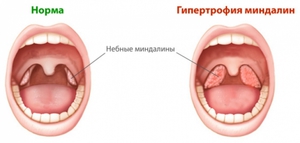 Every person at least once experienced pain and discomfort in the throat. When appearing unpleasant symptoms, the patient is independently trying to find the cause of their occurrence. However, many take healthy tonsils for pathology and begin to drug treatment without consultation. In order not to make such a mistake, it is important to know what a healthy throat looks like.
Every person at least once experienced pain and discomfort in the throat. When appearing unpleasant symptoms, the patient is independently trying to find the cause of their occurrence. However, many take healthy tonsils for pathology and begin to drug treatment without consultation. In order not to make such a mistake, it is important to know what a healthy throat looks like.
The tonsils are small. They do not go beyond the palatine arches (however, such a description is not absolute. In some people, enlarged tonsils are the norm, a feature of the organism);
- the glands are not fused with the palatine arches;
- tonsils have a pale pink color, there is no redness and plaque on them;
- small elevations visible on the surface of the glands;
- in other parts of the pharynx (soft palate, posterior mucous wall, tongue, tongue) there are no signs of inflammation;
- if you put pressure on the tonsils with a spatula, no liquid pus and caseous plugs are released;
- mucous neotechnaya, without pronounced follicles and vascular pattern.
The criterion of a healthy throat is the presence of all the listed symptoms together.
Glands and tonsils. What is the difference?
A person has 6 tonsils in his throat. Photo: 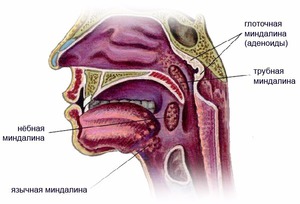 Nasopharyngeal,
Nasopharyngeal,
language,
Glands and tonsils are one and the same, the only difference is where the glands are located. This is the tonsils. The separation was done by the doctor for convenience.
Types of throat diseases
First symptoms sore throat are discomfort and pain. After examining the appearance of the oropharynx, you can see certain changes:
- swelling and redness of the posterior pharyngeal wall and soft palate . This indicates the presence of pharyngitis caused by bacteria and viruses;
- sore throat, redness and swelling of the tonsils without a certain plaque talks about the onset of sore throat; a yellow-white bloom appears later;
- herpangina characterized by the additional presence small bubbles. Opening, they turn into sores;
- purulent thick mucus running down from the nasopharynxand, is a sign of inflammatory adenoids, rhinitis or sinusitis;
- if throat appears caseous traffic jams or pus is excreted when pressed with a spatula on the tonsils - It speaks of chronic tonsillitis.
Caseous plugs are dense, ball-like formations that make the process of swallowing painful. They look like white spots on back wall throat and glands. They cannot always be seen immediately, since they are “hidden” in the almond folds;
- chronic cough in combination with enlarged follicles on the pharyngeal wall may signal chronic hypertrophic pharyngitis;
- white bloomcovering the entire mouth (gums, tongue, back wall of the pharynx, glands), speaks of a fungal infection that can occur with a decrease in immunity or after long-term antibiotic use.
Signs of sore throat
Symptoms of the sore throat appear several hours after the penetration of germs. Attention should be paid to the following signs:
With inflammation of the pharyngeal or lingual tonsils, the symptoms of inflammation may vary.
Signs of inflammation of the tonsils, which are in the root of the tongue are:
- discomfort and sore throat;
- swallowing disorder;
- gain pain sensations when sticking out the tongue;
- difficulty pronouncing words;
- heat.
When inflammation of the pharyngeal tonsil symptoms are expressed:
- difficulty in nasal breathing;
- mucous membranes purulent discharge from the nose;
- possible pain in the ears;
- temperature rise.
If you do not start to treat acute inflammation tonsils at the first sign, the disease can become chronic. Chronic tonsillitis can worsen several times a year. This has a negative effect on mental activity and performance. It also increases the risk of infection of the tissues of the kidneys, heart and joints.
Acute inflammation of the sore throat can be cured in 7–10 days with timely treatment, while treating chronic sore throat can take up to several months.
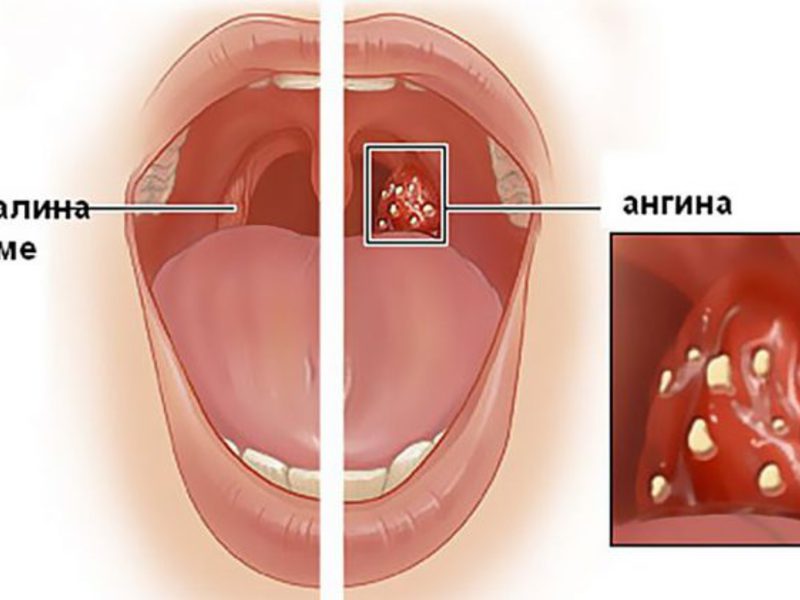
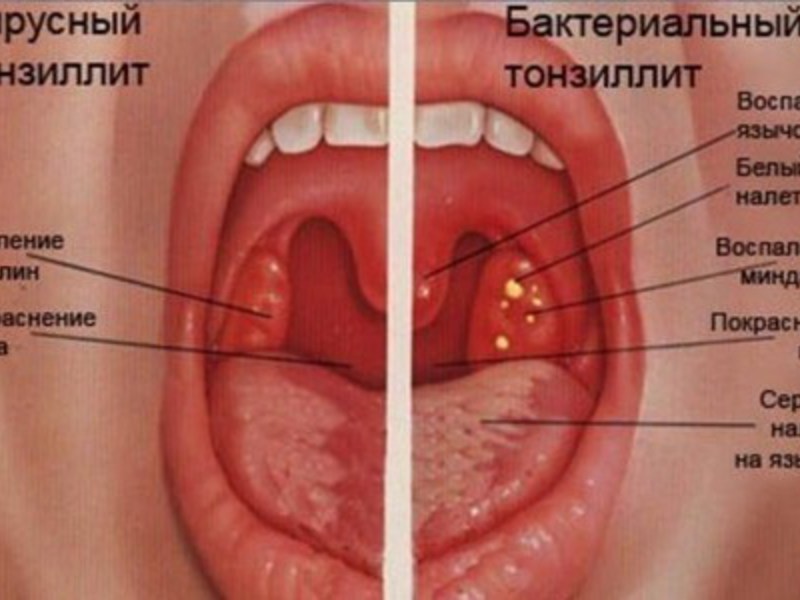
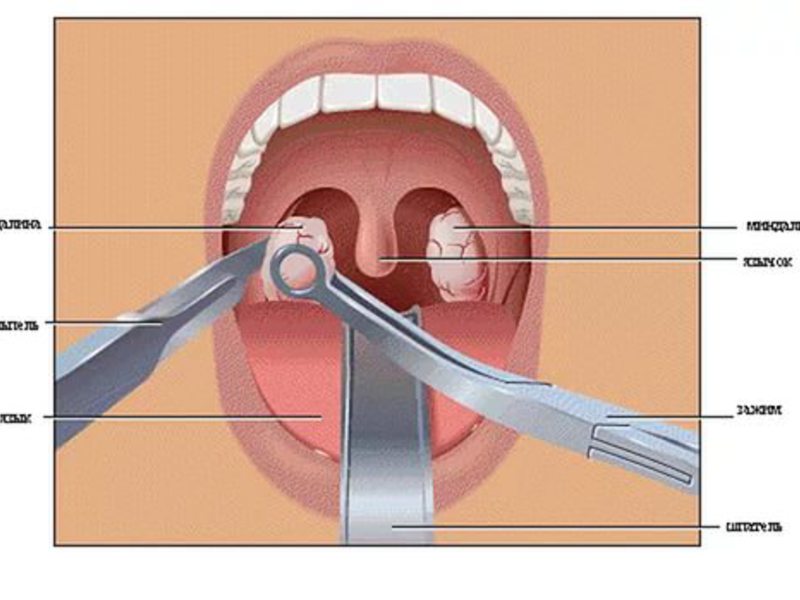
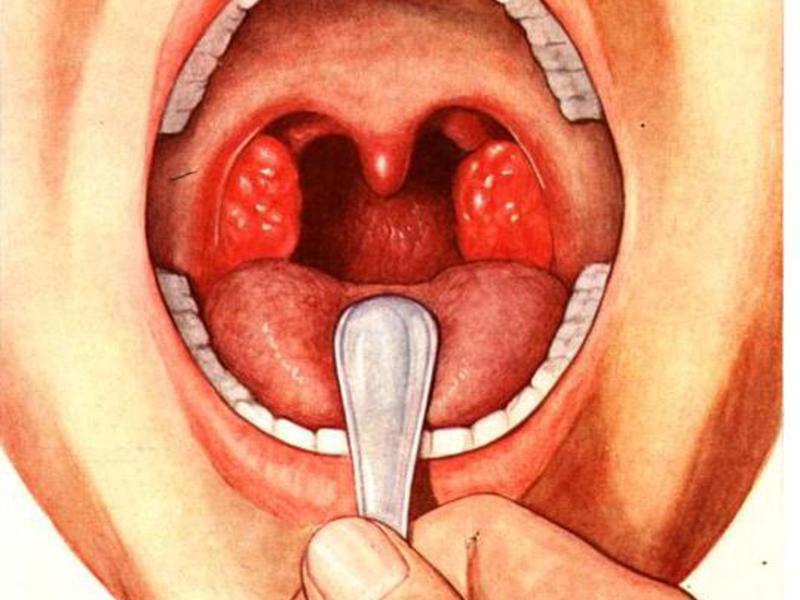
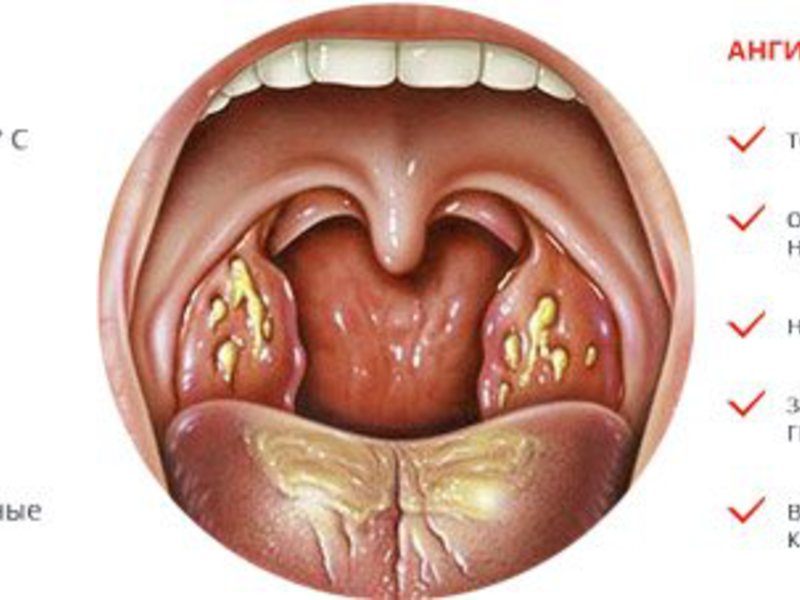
How to inspect the throat
The basic rules for examining the throat when signs of inflammation of the tonsils appear:
- it is very important for the examination of the throat to find the right lighting. In order to see well the distant parts of the throat, sunlight will not be enough. You can use the usual flashlight, which does not give a blue cold glow, which can affect the wrong perception.
- to inspect the throat, use a wooden disposable spatula or the back side of a teaspoon. To assess the state of the soft palate, glands, back wall, without causing emetic urges, it is necessary to press on the center of the tongue closer to its tip.
- in some cases, the signs are quite obvious, so the patient can be examined without a spatula. He can just open his mouth wide, pressing his tongue down.
- in order to increase the viewing area and eliminate the gagging urge, when viewed from the patient it is recommended to breathe deeply through the mouth
Treatment of sore tonsils
With the appearance of severely expressed pain and an increase in temperature, bed rest is necessary.
The first task is get rid of the infection and eliminate the cause of the disease. Do not self-medicate, the correct diagnosis can only be delivered by a specialist. Depending on him, medication will be prescribed.
Important comply with sanitary standards (mask mode, separate dishes, hygiene rules) to avoid infection.
One of the main treatments for throat disease is rinsingduring which the activity of pathogenic organisms is suppressed.
To rinse the throat use, diluted according to the instructions with water means:

To relieve the symptoms of inflammation of the throat and eliminate the pain also use lozenges, antiseptic pills:
- Strepsils - lollipops that contain amylmethacreazole ( local antibiotic) and lidocaine as an anesthetic;
- Decatilen is a bactericidal drug with a wide range of action;
- Neoangin - tablets with amylmetacresol, used for simple inflammation;
- Faringosept is an antibacterial topical containing active substance amazonmonohydrate.
In some cases, antibiotics should be used to treat the throat. They are necessary in the presence of follicles or plaque pus. These antibiotics include:
- Amoxicillin - effective antibioticused against numerous strains of pathogenic bacteria. It should be borne in mind that in parallel with this medication it is necessary to take drugs that normalize the work of the gastrointestinal tract;
- Amoxiclav is an antibiotic that contains clavulanic acid and others besides amoxicillin.
Sore throat is further treated folk remedies. This is a rinse saline With salt.
To reduce the pain using a solution of lemon juice. A decoction of sage, chamomile, calendula, eucalyptus will help reduce inflammation. You can add a spoonful of honey.
In the inflammatory processes of the tonsils, compresses from cabbage, onion inhalations, and salt dressings will help to improve the condition.
Throat disease prevention
To prevent inflammatory processes, it is necessary to maintain the protective functions of the body and strengthen the immune system. It is necessary to give up bad habits, balance the diet, try to minimize the possibility of damage to the tonsils:
- do not drink cold liquid;
- avoid hypothermia;
- cure, if necessary, the sources of infection (rhinitis, caries, sinusitis, sinusitis, sinusitis).
Having noticed the first signs of infection, it is important to immediately consult a doctor who will prescribe a treatment. Late treatment may lead to irreversible effects such as rheumatism and cardiovascular diseases.
With the onset of cold weather, adults and children begin to get sick with colds and acute respiratory diseases. One of the most common symptoms of these ailments is inflammation of the tonsils in the throat.
The gland is an organ located in oral cavity and nasopharynx, it consists of lymphoid tissue and nodules that produce lymphocytes. Some of these cells enter the bloodstream, while the rest remain in the tonsils and create local immunity. In infancy, the glands also perform a hematopoietic and enzymatic function.
There are four types of tonsils:
- palatine
- nasopharyngeal;
- pipe;
- lingual.
Independently, you can only see the first, to do this, rather wide open mouth.
Causes of tonsil inflammation
When an infection enters the body, the glands first begin to resist it. When immunity reserves are reduced, a pathological process occurs, called tonsillitis or sore throat.
Most often, this disease is provoked by streptococci, staphylococci, pneumococci and meningococci. They enter the body upon contact with a sick person. Pathology can occur as a result of a decrease in the protective function, in which case the opportunistic flora becomes the causative agent of the disease.
In the presence of a chronic focus of infection in the nasopharyngeal tonsillitis will be a common occurrence. Sinusitis, rhinitis, caries, gum disease provoke them.
Serve as a cause of sore throat can also mushrooms and various viral infections (herpes, adenovirus). They are transmitted by contact-household and airborne droplets.
Contribute to the development of tonsillitis can such states:
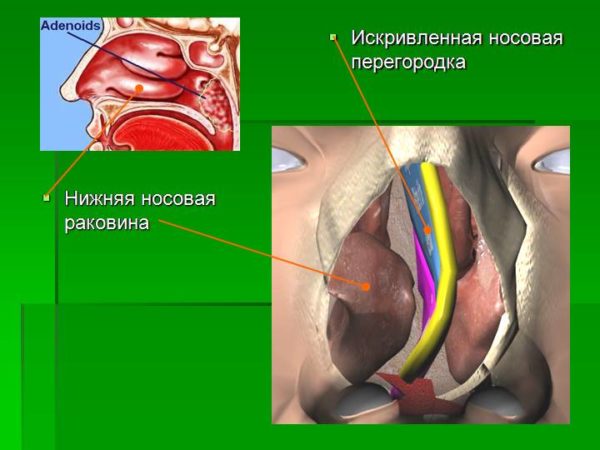
Most often, a sore throat occurs as an independent disease, but there are cases when it accompanies other infectious diseases: scarlet fever, measles, diphtheria. Most often, children have tonsillitis; an unstable immune system causes this.
Symptoms of the disease
The first manifestations of the disease can occur within a few hours after hypothermia, or contact with the carrier of the infection. It all depends on the general state of the body at the time of infection.
Main symptoms acute tonsillitis are such:
- increase and hyperemia of visible tonsils;
- sore and sore throat;
- lymph node change;
- malaise;
- loss of appetite;
- hyperthermia;
- chills;
- intoxication of the body;
- loss of performance.
After the infection drops below airwayreaching up vocal cords, hoarseness of voice may appear, it becomes difficult for the patient to speak, especially after a long silence.
In small children, symptoms typical for a sore throat are the rejection of the breast (bottle), a sharp rise in temperature, moods, crying, an increase in the submandibular and parotid lymph nodes. This disease is especially dangerous for babies, as it has a lightning current. As a result, the bloodstream infection spreads very quickly throughout the body and pathological lesions in other organs may appear.
Forms of tonsillitis
There are four types of tonsillitis, in their symptoms they differ among themselves.
Catarrhal sore throat
This form of the disease is the easiest to follow. It is characterized by an increase in the tonsils, hypertrophy and hyperemia of the mucous membrane. Ill worry discomfort throat when swallowing, scratchy, increased body temperature. 
If you go to the hospital in time and start treatment, the pathology disappears quickly and does not go into a more difficult stage.
Lacunar angina
This disease is difficult and more difficult to treat. It manifests itself more often in people with chronic infections in the mouth and nasopharynx. The first signs are noticeable 5 days after hypothermia or contact with a sick person. This form is characterized by acute course and education purulent plugs in gaps of glands.
The patient feels general weakness, body aches, hyperthermia, severe pain in the throat, symptoms of intoxication.
On examination, the doctor notes a significant increase in the tonsils, they are hyperemic (red), covered with a whitish bloom. For lacunar tonsillitis, the presence of purulent islands on the glands is typical. The process involved and bow.
In children, this form of tonsillitis is quite difficult and can cause many complications. With frequent remissions, the disease becomes chronic. If you start treatment in time, relief will come in 3-4 days.
Follicular sore throat
Such tonsillitis is also characterized by an acute course, when it inflames the follicles of the tonsils.
On examination, the doctor will identify changes in the glands and larynx, they will be enlarged and covered with mucus and plaque. The lymph nodes grow and become painful on palpation.
The difference of this form from lacunar is that the intensity of pain is much less and there is no high temperature.
Quinsy
This is the most difficult and dangerous course of tonsillitis. It can inflame the tonsils, larynx, tissues located nearby. In most cases, only one gland is affected.
In addition to the general symptoms, the following manifestations are typical for the phlegmonous stage:
- swelling and hyperemia of the soft and hard palate and surrounding tissue;
- hoarseness;
- fetid odor from mouth;
- violation of the jaws.
If such signs appear, it is impossible to delay in going to the doctor; complications can be very serious. 
Treatment of tonsillitis
The tactics of patient management in different forms of angina is slightly different. Mild stages can be treated at home under the supervision of a doctor. In more severe cases, when there is edema of the mucous membrane, necrosis, severe symptoms of intoxication in a patient, it is necessary to carry out treatment in a hospital.
The main principles in therapy are as follows:
- bed rest;
- rinsing;
- taking antipyretics;
- irrigation of the throat with antiseptics;
- abundant warm drink;
- resorption of anti-inflammatory tablets.
Soda-salt solutions with the addition of iodine droplets, decoctions of herbs, chlorhexidine-based medicines are well suited as rinses. To reduce the temperature using drugs Paracetamol, Ibuprofen.
In case of severe intoxication, various fruit drinks, wild rose tea, herbs, warm tea with lemon help. In more severe cases, intravenous infusion therapy is prescribed.
Treatment of angina with purulent foci is carried out with antibacterial drugs. The exception is the catarrhal form, in this case, the doctor looks individually according to the degree of neglect of the disease. The most commonly used antibiotics are Amoxiclav, Sumamed, Ceftriaxone. The course of treatment is at least 7 days.
If a drug therapy it does not help, or there are large areas of tissue necrosis, they resort to surgical intervention. This may be the excision of dead areas, and the complete removal of the tonsils.
In order to cure the disease as soon as possible and much faster, the patient should immediately consult a doctor when the first symptoms appear.
Tonsils in the human body perform one of the main roles. They protect the respiratory system from the penetration of alien flora. An infection causes inflammation of the tonsils. This disease occurs in many people and in practice it is commonly called tonsillitis or tonsillitis. What are the causes of this phenomenon and how to overcome inflammatory process?
Inflammation in the tonsils almost always occurs on the background infectious disease. Microbes enter the respiratory system in a variety of ways through the nose and mouth.
But the glands are inflamed for reasons of:
- respiratory infection. The human body is regularly attacked by viruses and bacteria in the form of pneumococci, staphylococci and streptococci;
- hypothermia. The peak of the development of the inflammatory process in the tonsils in the throat occurs in spring and autumn. It is at this time that the immune function is weakened due to the lack of vitamins;
- the presence of chronic foci of infection. Doctors found out that the reason is incomplete teeth;
- obstructed nasal breathing. In this process, in the cold season, the tonsils are supercooled, which is why local immunity is sharply reduced.
By nature can be viral, bacterial, fungal or herpetic. Only an experienced specialist can determine the shape. In this case, their treatment will differ significantly from each other.
The manifestation of catarrhal angina
With the defeat of the surface layer of the glands, it is customary to talk about the development of a catarrhal angina. This type of disease is considered the easiest. But if left untreated, it can lead to complications.
In this case, tonsil inflammation is characterized by:
- sharp painful sensation throat when swallowing and talking;
- increasing temperature indicators to 37.5 degrees;
- minor intoxication of the body;
- redness of the tonsils, swelling, no plaque;
- an increase lymph nodes under the jaw area;
- general weakness and soreness in muscle structures;
- heat in the throat.
Inflammation of the tonsils in childhood is manifested by a strong painful feeling in the throat area. But such a process leads to instantaneous loss of fluid. The patient's condition is greatly weakened, therefore, requires a gentle treatment. In adults, it is easier.
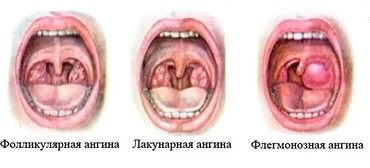
Therapeutic measures for catarrhal form
Even mild inflammation of the tonsils can be accompanied by the development of a serious condition. Such a process threatens to dehydrate the body, so you should not hesitate to call a doctor. Catarrhal sore throat can be a sign not only of tonsillitis, but also a manifestation of diphtheria or scarlet fever.
Medical events in childhood are in compliance with several recommendations.
- If a child has inflammation of the tonsils, the symptoms should be eliminated with antibacterial and antipyretic agents. Often, antibiotics are prescribed as Amoxiclav, Flemoxin or Augmentin.
- It is important at this time to observe strict bed rest. Walking and shopping are strictly prohibited. This period should last up to seven days.
- When inflammation of the pharynx is necessary to gargle. At the same time, their multiplicity should reach up to ten times a day. For such purposes, herbal infusions, soda or saline are perfect.
- Follow strict drinking regime. If the baby refuses to drink, then you need to water him one spoon every five to ten minutes.
Treatment of a child with catarrhal sore throat can take place at home under the supervision of a doctor.
How to treat tonsil inflammation in adults? The whole process depends on the general condition of the patient. If the state of health is satisfactory, then it is enough to gargle and use for irrigation of the throat. antiseptics. Antibiotics may be prescribed for quick recovery. As an additional treatment, pills for sucking, compresses on the throat are suitable.

The most severe forms of angina
If a sore throat catarrhal in nature has not been treated, the patient's condition worsens. Then he has purulent inflammation tonsils. There is a profound defeat of the pharyngeal tissues and the formation of yellowish plaque. In this situation, angina is divided into several forms. Follicular sore throat is a disease that is characterized by small patches.
If the amygdala in the throat is covered with purulent strips, then they say about. Treatment methods are no different, and the signs also have similarities.
Inflammation of the pharyngeal tonsil of the purulent type is characterized by:
- dryness in the mouth;
- cough and sore throat;
- strong painful feeling when swallowing;
- the formation of follicles with purulent contents inside;
- severe weakness of the body;
- temperature increase up to 40 degrees;
- constipation in adults;
- vomiting and diarrhea in childhood.
When the tonsil in the throat is covered with pus, then this process is dangerous for the general condition of the body. Because of this, various complications can occur in the kidneys, blood vessels and heart muscle.

Therapeutic measures for severe angina
Lacunar and follicular sore throat are considered the most common diseases, so everyone should know how to cure them.
For babies under five, purulent damage to the tonsils is dangerous. Therefore, you should not hesitate to call a doctor. But where are the children at the time of treatment? Often when they are placed in a hospital. They are given intravenous antibiotics and replenish the supply of lost fluid.
If the treatment is carried out at home, you must use:
- washing the lacunae and follicle with antiseptic solutions;
- suction of purulent contents using vacuum. This procedure is performed in a hospital;
- local injections;
- treating the tonsils with an oily solution;
- physiotherapy;
- vitamin complexes and immunomodulatory agents to enhance immune function.
Nutrition for tonsillitis should be gentle and consist of liquids, cereals and mashed potatoes.
The occurrence of phlegmonous sore throat
The amygdala in the throat can also be exposed to such a disease as phlegmonous sore throat. This type of disease is considered a complication of follicular or lacunar tonsillitis, when the purulent contents overwhelm the tissue.
There is inflammation of the tonsils on one side. In this case, the disease can develop both on the right and on the left side. With this disease, the patient has an acute painful feeling in the throat, an increase in temperature indicators up to 39-40 degrees, weakness, increased drooling.
If the treatment of inflammation of the tonsils is started out of time, then the patient may experience an abscess. Therapeutic measures are no different from previous lesions. The patient is also prescribed antibacterial agents, antipyretic drugs, a large volume of fluid, antiseptics.
After the end of the acute period, vitamin complexes and immunostimulating medications are included in the therapy. For five days, you must comply with strict bed rest. If an abscess occurs, an urgent surgical intervention is carried out to remove the abscess, followed by washing.
Inflammation of the pharyngeal tonsil
Nasopharyngeal tonsil is popularly called adenoids. As soon as the inflammatory process occurs, they begin to grow in size. If the disease is observed regularly, the tonsils simply do not have time to recover, resulting in a chronic inflammation.
If there is inflammation of the tonsils, the causes may be hiding in a bad environment, allergic reaction, frequent colds, weakened immune function. Most often this problem occurs in children under the age of ten years. But after fifteen years they begin to decrease in size.
The main signs of tonsil disease are attributed to:
- runny nose protracted;
- constantly shortness of breath;
- breathing through the mouth;
- regular catarrhal diseases, the interval between which is two to three weeks.
With the development chronic disease it is necessary to remove adenoids. If this is not done in time, then the child may experience complications in the heart muscle or kidney, and the upper jaw defect may also develop.
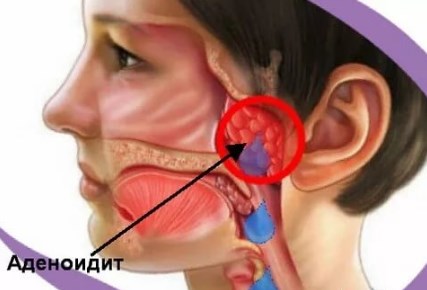
Therapeutic measures for adenoiditis
After a poorly cured disease, there is a relapse at intervals of several weeks. To prevent this, it is necessary to pay attention to the symptoms and visit the doctor. With the right treatment tactics, it is possible to avoid a variety of complications.
Therapeutic measures for adenoiditis are:
- washing the nasal passages with saline. In this case, this procedure should be carried out not only during the illness, but also after it;
- the use of medicinal herbs inside;
- use of anti-inflammatory drops;
- use of immunostimulating agents and vitamin complexes;
- carrying out physiotherapy.
If during long-term treatment is not observed positive dynamics, and the tonsils do not return to the opposite position, they will have to be removed. But after that, the larynx area will become even more vulnerable to the effects of the infection. Then this process will lead to chronic tonsillitis, otitis and sinusitis.
Defeat of lingual tonsils
This type of inflammatory process is extremely rare. The defeat of the lingual tonsil is observed only when the patient regularly suffers from catarrhal, follicular and lacunar type tonsillitis.
Acute inflammatory process in the tonsils or pharynx indicates extensive damage to the infection that joins the uvula. As a result, the patient has symptoms in the form of swelling of the tongue, difficulties in chewing and swallowing, speech disorders. Also, there is an increase in temperature indicators to 39-40 degrees.
The treatment process involves taking antibacterial drugs, adherence to bed and drinking regimen, the use of fortifying agents. If there is a lack of effect or the development of an abscess, then the lingual tonsil is removed. The recovery process will be long and difficult, as it can lead to speech disorders and the implementation of chewing and swallowing movements.
In the event of the first signs of tonsil inflammation, an urgent need to visit a doctor. If for an adult such a process is not very dangerous, then it can bring a strong harm to the child.
Accumulations of lymphoepithelial tissue that are located in the oral cavity and nasopharynx are called the tonsils, colloquially - glands. It is difficult to meet such a person who at least once did not encounter their inflammation. Let us consider in more detail what the tonsils are and what a person needs them for.
Depending on their location, the amygdala is divided into:
- Paired: palatine, tubal.
- Unpaired: lingual, pharyngeal.
In addition to this classification in medicine, it is customary to number the tonsils as follows:
- palatine - 1 and 2;
- pharyngeal (adenoids) - 3;
- lingual - 4;
- pipe - 5 and 6.
In addition, there are small accumulations of lymphoepithelial tissue on the back of the throat, they are called follicles. Together, these formations of the throat are called the Valdera-Pirogov ring or lymphoid ring.
What are the tonsils for?
Man is born with glands. In the first years of life they reach maximum development. From the moment of the appearance of sex hormones (15-16 years old), the reverse process occurs, and they gradually atrophy and decrease.
All the functions of the glands in the human body are still not fully understood. Their main role is the protection and creation of local immunity against pathogenic microorganisms that penetrate the human body by airborne droplets.
In addition, the glands perform a hematopoietic function in young children and secrete enzymes that are involved in oral digestion.
Important! Glands can give a characteristic shade of speech and voice timbre. This moment must be considered when removing them from patients whose work is connected with the vocal apparatus (singers, broadcasters, etc.). The so-called "French pronson" can sometimes be the result of enlarged adenoids or hypertrophy of the tonsils.
Appearance and location
Patients are often concerned about the location of the tonsils, many want to consider them in themselves or in their child. Unfortunately, you can only see for yourself the palatine tonsils or excessively enlarged pharyngeal. Others are available only to a specialist using special tools.
To see all the structures with your own eyes, you can pass a diagnostic examination using endoscopic equipment connected to a computer monitor. In this case, the doctor can easily see all the glands and screen the patient where they are and how they look.
Palatine tonsils
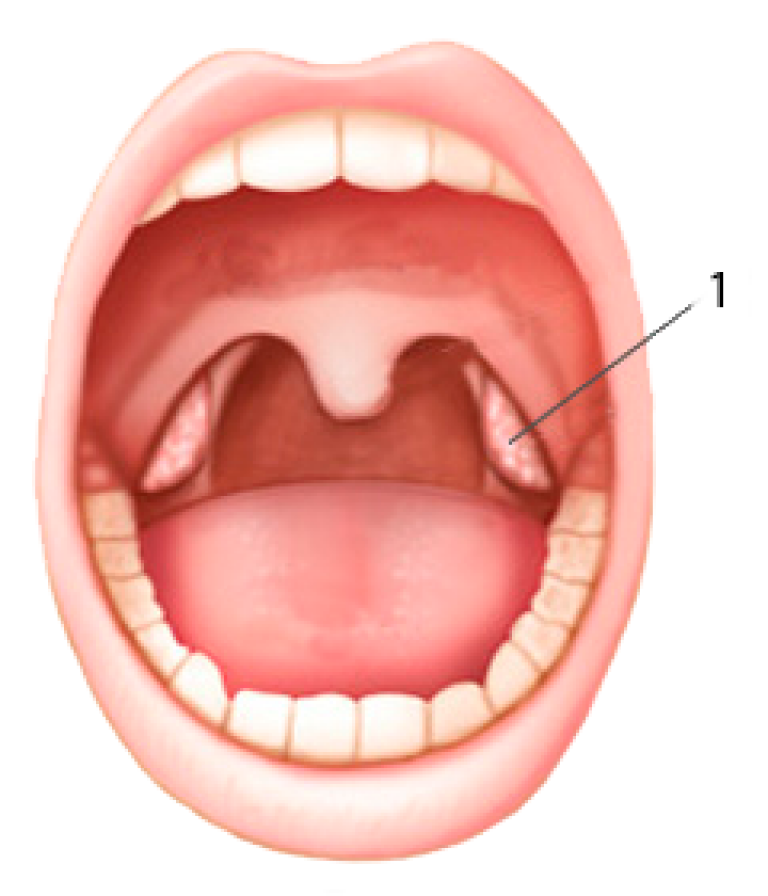
Palatine tonsils
These lymphoid formations are located in the tonsillar niches between the two palatine arches. These are the only tonsils that the patient can see on his own by simply opening his mouth wide.
The structure of the palatine glands is as follows: the free surface faces the pharynx and is covered with a multi-layered epithelium. Each palatine tonsil has deep gaps of about 10 -15, which are called lacunae (crypts). Patients can perceive these gaps as peculiar "holes". Its other surface is tightly bonded to the lateral surface of the pharynx using a capsule.
Connective tissue jumpers move from the capsule deep into. The lacunas branch out and form a tree-like network in the thickness of the tissue. The epithelium, waste of germs, is rejected into the lumen of these lacunae, which serves as a substrate for the formation of almond plugs.
Nasopharyngeal or Pharyngeal Tonsil
It is more commonly known as adenoids or adenoid vegetations (growths). This formation is located on the posterior fornix of the nasopharynx. Independently to see where they are located and how they look will not work, unless they grow to such dimensions that they hang over the tongue.
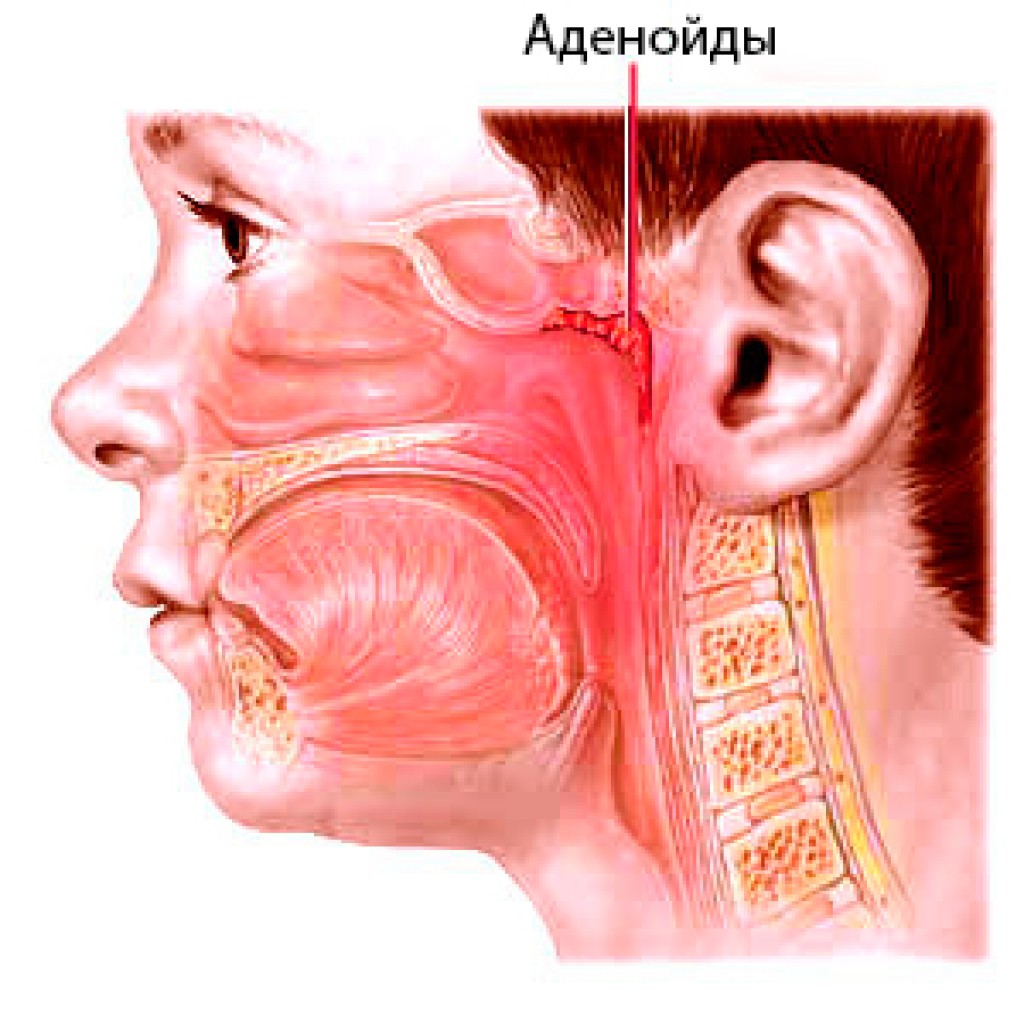
The location of the adenoids
Most big problem Pharyngeal tonsil presents to children and their parents. Enlarged adenoids interfere with normal breathing, contribute to hearing loss and the development of otitis. They are observed and treated using conservative and surgical methods.
Tubular tonsils
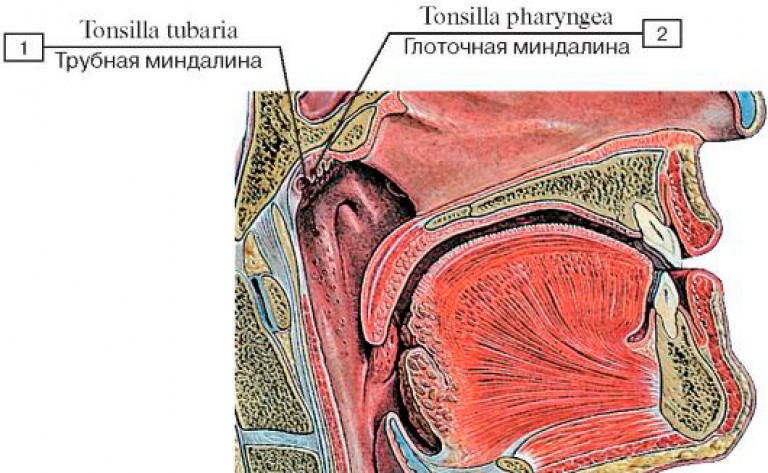
Pipe and pharyngeal tonsils are almost in one place
Tubular amygdala steam room. It is quite small in size and is located at the mouth auditory tube in the nasal cavity. Their schematic image is presented in the photo.
An enlarged tubal tonsil can cause hearing problems and frequent otitis, since during hypertrophy it overlaps the message of the nasal cavity and middle ear.
Tongue tonsil
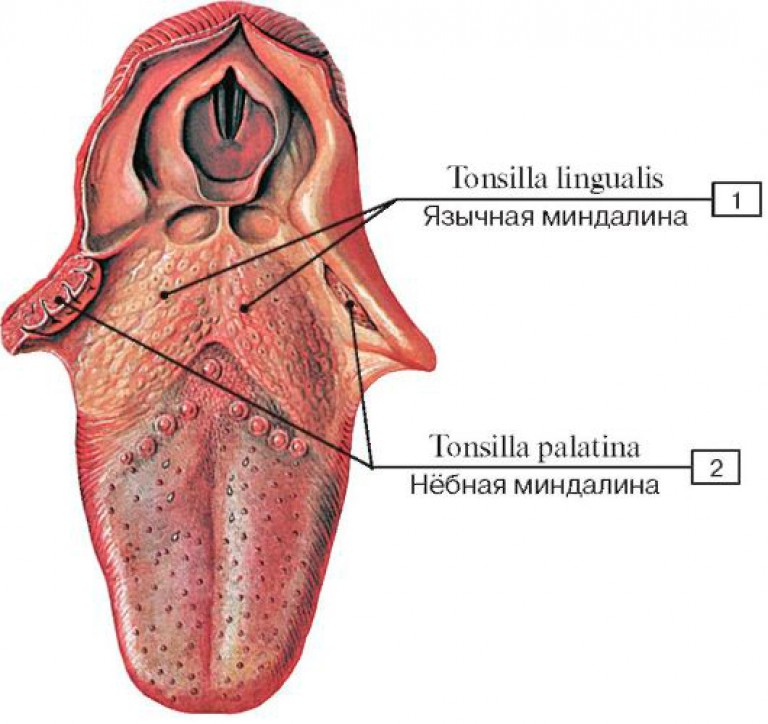
The location of the lingual tonsil
This education is at the root of the language. Externally, it is hilly and rough. Inflammation of the lingual tonsil causes sharp pain while talking and eating.
Types of inflammation and disease
The function of the tonsils is to protect the body from germs coming from the air. With a decrease in immunity and violation of their work, the following diseases may occur:
- Inflammation of the tonsils (sore throat). Under angina usually mean inflammation of the tonsils, as this disease occurs more often than others. If another tonsil is inflamed, the diagnosis will be: angina of the lingual tonsil or adenoiditis, etc.
- Hypertrophy (increase in size) of the glands. Tissue growth itself is not a disease in itself, but enlarged adenoids impair breathing and hearing, and hypertrophied palatine tonsils can interfere with eating and talking normally. Whether it is a disease or not depends on the degree of hypertrophy and the presence of associated complications.
- Chronic tonsillitis. This is a complex autoimmune inflammatory reorganization of palatine tonsil tissues, which can cause the development of diseases of other organs and systems (glomerulonephritis, rheumatism, endocarditis, etc.).
- Benign and Malignant Neoplasms.
Questions to the doctor
Are the tonsils and tonsils of the throat the same or different?
The amygdala and gland are one concept, these words have a different origin: the word gland means “iron”, and the word almond comes from the ancient Greek “almond”. In medicine, the first term is more often used, although “glands” is also true.
What is the amygdala and where is it located?
The amygdala or cerebellar tonsil is an accumulation of nerve cells in the temporal lobe of the brain. It is the center of fear and pleasure. It has nothing to do with all the glands located in the oropharynx, except for a similar name.
Why does a person need such a complex throat structure?
The main function of the tonsils is to protect against infection; besides, they play a role in the formation of immunity and blood formation. Such a structure allows them to perform their role well and protect the body.
I found myself in the holes in the tonsils. Is it a disease or are they needed for something?
The so-called "holes" are lacunae of the glands, in some people they are more pronounced, others are weaker. Pathological contents (corks) can accumulate in the lacunae, in these cases it is removed by washing.
Hypertrophy (enlargement) can affect other organs: cause otitis, reduce hearing, or cause inflammation. In these cases, the tonsils are recommended to get rid of.
Popular
- Why seals may appear
- Blood disorders in children
- What can not drink a pill
- Blood disorders in children
- Blood disorders in children
- Bones: structure, composition, types of bones, types of connections and their characteristics
- How many live with lung cancer
- Influenza in children: how to treat, what can and cannot be done to parents, what medicines will help?
- "They are people too ..." - you say
- What helps "Prednisolone"




